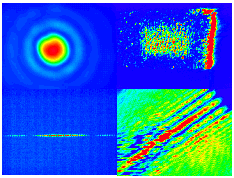Labs
The following 5 subjects will be covered. A laboratory report has
to be produced for each one of them.
1)
Reflection and Refraction
All tables: To work on during 08/31/09-09/16/09.
As preparation, read Hecht chapter 4, especially section 4.3, 4.4, 4.5,
4.6 and 4.7, and of course read the lab manual for experiment 1.
2) Polarized Light
All tables: To work on during 09/21/09-09/30/09.
As preparation, read Hecht chapter 4, especially section 4.6 and
chapter 8, especially section 8.1, 8.2, 8.3, 8.4, 8.5, 8.6, and 8.7,
and of course read the lab manual for experiment 2.
3) Geometrical Optics
All tables: To work on during 10/05/09-10/21/09.
As preparation, read Hecht chapter 5, especially section 5.1 to 5.5,
and of course read the lab manual for experiment 2.
4) Interference
All tables: To work on during 10/26/09-11/04/09.
5) Fresnel vs.
Fraunhofer Diffraction and Fourier Optics
To work on during 11/09/09-11/25/09.
6) One experiment of your choice
All tables: To work on during 11/30/09-12/02/09.
08/31/2009: 1st
lab session - Today you will identify the provided equipment, complete
the equipment inventory, and align the
laser on your optical bench. You will then
start to set up experiment 1.
Lab report
The structure of your lab report should follow these guidelines:
1. Title
2. Author
3. Abstract
1. Describing the goal
of the experiment
2. The method used for
achieving it
3. A short summary of
the results
4. A list of
especially interesting findings
4. Introduction
1. Describing the
background of the topic being investigated. Why is the goal of the
experiment of interest?
2. How have similar
measurements been done in the past, why is it done again here?
3. Include general
theory, meaning theory that does not only apply to
your experiment. For experiment 1, for example, the introduction should
mention Snell's law.
5. Theory
1. Review of the
theory that is used in the experiment. Here you should use some
judgment on whether a theory is very general and should be in the
introduction, or whether it is more special to the experiment, and
should therefore be in this section. The theory of Fresnel's equations
is general and should be in the introduction. Brewster's angle is a
corollary of that theory and could therefore also be in the
introduction. However, you could also take the view that it is the
specific corollary that you use for experiment 2, and you could
therefore put it into this theory section.
2. Derivation of
general formulas that will be used. For experiment 1C, for example,
this would include the derivation of how n is related to the minimum
angle of refraction. For experiment 2, for example, the last equation
in the manual with tan over sin to get the difference between the phase
advances in the overhead transparency should be derived here. But as I
said in class, it might be a challenge to derive it without help, so
you do not have to include a derivation. For this time, just reference
the lab manual. But describe well which angles have to be used in for
this formula.
6. Experimental setup and results
1. Graph of setup. For
experiment 1C, for example, you could describe how the prism is mounted
and how you measured the minimum angle.
2. Quantities measured'
3. Sources of errors
4. Data and their
errors in graphs
5. Data evaluation
leading to the measurement result and its error estimate
6. Error analysis.
Complex formulas for the error analysis should be in an appendix
7. Conclusion
1. Summary of results
2. List of especially
interesting findings
3. Suggestion of
improvements or how to continue the work
8. Acknowledgments
Quizzes and Final Exam
Before you can start your experiment, you have to read the relevant
sections of this manual and of the textbook by Hecht. Then you have to
pass a short oral quiz in the laboratory. Furthermore you must hand in
the report of your previous experiment. The final exam covers the
material that was covered in class as well as
the experiments.

 Dates
Dates
 Literature
Literature
 Labs
Labs
 Quizzes and Final Exam
Quizzes and Final Exam
 Preparation
Preparation
 Grading
Grading
 Academic Integrity
Academic Integrity

 Dates
Dates
 Literature
Literature
 Labs
Labs
 Quizzes and Final Exam
Quizzes and Final Exam
 Preparation
Preparation
 Grading
Grading
 Academic Integrity
Academic Integrity